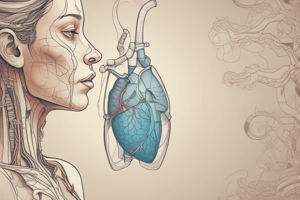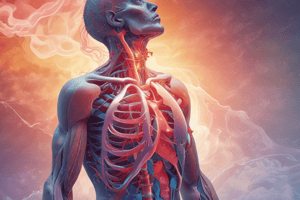Podcast
Questions and Answers
¿Cuál es la función principal de las válvulas dentro del corazón?
¿Cuál es la función principal de las válvulas dentro del corazón?
- Bombear sangre a través del cuerpo
- Asegurar que la sangre fluya solo en una dirección (correct)
- Permitir el flujo sanguíneo en ambas direcciones
- Mantener la presión sanguínea dentro del corazón
¿Cuál es la función principal de las arterias en el sistema cardiovascular?
¿Cuál es la función principal de las arterias en el sistema cardiovascular?
- Transportar sangre oxigenada desde el corazón hacia los órganos y tejidos (correct)
- Facilitar el intercambio de gases entre la sangre y los tejidos
- Transportar sangre desoxigenada al corazón
- Mantener la presión sanguínea requerida para una circulación eficiente
¿Cuál es la principal función de los capilares en el sistema cardiovascular?
¿Cuál es la principal función de los capilares en el sistema cardiovascular?
- Llevar sangre desoxigenada desde los órganos hacia el corazón
- Transportar sangre oxigenada hacia el corazón
- Facilitar el intercambio de materiales entre la sangre y los tejidos (correct)
- Mantener la presión sanguínea adecuada en el cuerpo
¿Cuál es el principal objetivo del sistema respiratorio?
¿Cuál es el principal objetivo del sistema respiratorio?
¿Cuál es el principal sitio de intercambio gaseoso en el cuerpo humano?
¿Cuál es el principal sitio de intercambio gaseoso en el cuerpo humano?
¿Cómo se coordinan los sistemas cardiovascular y respiratorio para garantizar un intercambio gaseoso adecuado?
¿Cómo se coordinan los sistemas cardiovascular y respiratorio para garantizar un intercambio gaseoso adecuado?
¿Cuál es la función principal del sistema cardiovascular?
¿Cuál es la función principal del sistema cardiovascular?
¿Cuáles son los componentes clave del sistema cardiovascular?
¿Cuáles son los componentes clave del sistema cardiovascular?
¿Cuál es la función principal del corazón en el sistema cardiovascular?
¿Cuál es la función principal del corazón en el sistema cardiovascular?
¿Qué función desempeña el lado izquierdo del corazón?
¿Qué función desempeña el lado izquierdo del corazón?
¿Qué papel juega el sistema respiratorio en el cuerpo humano?
¿Qué papel juega el sistema respiratorio en el cuerpo humano?
¿Qué función tiene el lado derecho del corazón en la circulación sanguínea?
¿Qué función tiene el lado derecho del corazón en la circulación sanguínea?
Study Notes
Introduction
The cardiovascular-respiratory system (CVRS), also known as the cardiopulmonary system, plays a vital role in maintaining life-supporting functions within the human body. As the primary interface between the internal environment and the external world, this system ensures the efficient delivery of oxygen (O2) to the tissues and the timely elimination of carbon dioxide (CO2). The two components of the CVRS, the cardiovascular system (CVS) and the respiratory system (RS), work synergistically to achieve these goals.
Cardiovascular System
The CVS consists of the heart and blood vessels, including arteries, veins, and capillaries. Its primary function is to transport O2, nutrients, and other substances to the cells and tissues of the body, while simultaneously removing waste products like CO2. The key components of the CVS include the heart, which pumps blood through the blood vessels, and the blood itself, which serves as the medium for transportation.
Heart Functions
The heart is responsible for pumping blood through the blood vessels to deliver oxygen and nutrients to the body's cells. It also aids in waste disposal by carrying CO2 from the tissues back to the lungs for elimination. The heart is divided into two sides: the left side, which receives oxygenated blood from the lungs and pumps it through the body; and the right side, which collects deoxygenated blood from the organs and sends it to the lungs for fresh oxygenation. Valves within the heart ensure that blood flows only in one direction, preventing backward flow.
Blood Vessels
Arteries are responsible for transporting oxygenated blood away from the heart to the various organs and tissues in the body. They have thick walls to maintain the pressure required for efficient circulation. Veins bring deoxygenated blood back to the heart after it has supplied oxygen and nutrients to the tissues. Capillaries are the smallest blood vessels, where the exchange of materials between the blood and tissue occurs. These microscopic structures form a vast network throughout the body that allows for effective communication between the CVS and the surrounding tissues.
Respiratory System
The respiratory system is tasked with maintaining the balance of oxygen and carbon dioxide within the body. It achieves this by facilitating the exchange of these gases between the air we breathe and the blood circulating within our body. The main components of the respiratory system include the lungs, trachea, bronchi, bronchioles, and alveoli.
Lungs
The lungs are the primary site for gas exchange in the human body. They contain hundreds of millions of tiny air sacs called alveoli, where oxygen from the incoming breath diffuses through a thin membrane into the bloodstream and CO2 from the bloodstream diffuses out into the exhaled air. This process ensures that the body's cells receive a constant supply of oxygen while waste products like CO2 are expelled.
Interactions Between Cardiovascular and Respiratory Systems
The CVRS functions in an integrated manner to ensure efficient delivery of oxygen and removal of carbon dioxide throughout the body. Changes in cardiac output and pulmonary ventilation directly affect the amount of oxygen and CO2 transported, respectively to and away from the tissues. Local metabolic control mechanisms involve changes in blood flow due to variations in the concentrations of blood gases, ultimately affecting systemic resistance and leading to vasoconstriction or vasodilation. These adjustments demand tight coordination between blood flow and lung ventilation, ensuring adequate gas exchange for optimal cellular function.
Studying That Suits You
Use AI to generate personalized quizzes and flashcards to suit your learning preferences.
Description
Este texto describe la anatomía y funciones del sistema cardiovascular, compuesto por el corazón y los vasos sanguíneos, así como del sistema respiratorio, que incluye los pulmones y las vías respiratorias. Se explora la interacción entre ambos sistemas para garantizar la oxigenación de los tejidos y la eliminación del dióxido de carbono.




